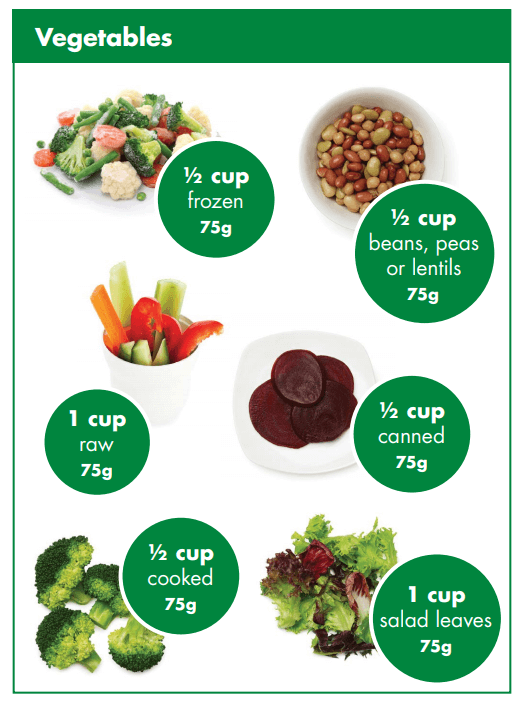Health benefits
Go for 2 serves of fruit and 5 serves of vegetables each day to help prevent:
- Constipation
- Heart disease
- Stroke
- Some cancers
- Overweight and obesity
Eating plenty of fruit and veg can also reduce your blood pressure and cholesterol levels, and improve control of type 2 diabetes.
What is a serve?
What if you eat a bowl of salad? Or a banana? Or a cob of corn? What makes a serve?
One serve is:


Fruit and vegetables to limit or eat in small amounts
Fruit juices |
Small amounts (half a cup or less) of 100% fruit juice are okay to have occasionally. When you juice fruit, you squeeze all the sugar into a glass and throw away the fibre, which is the best bit! Fibre helps fill us up and stabilise our blood sugar levels. A 250 ml glass of orange juice has almost 6 teaspoons of sugar and although it does contain some vitamins, it's better to drink water and eat a whole piece of fruit instead as it has more vitamins and fibre, and will be more filling. Juice is also acidic which can have an erosive effect on teeth. |
|---|---|
Dried fruit |
30g of dried fruit (for example, 4 dried apricot halves, 1½ tablespoons of sultanas) can be included occasionally. Dried fruit, if eaten in large quantities, can contribute to tooth decay because it contains a concentrated form of sugar that sticks to your teeth. |
Chips |
Fried vegetables such as potato and vegetable chips and crisps, add extra kilojoules and salt. These foods don’t count as part of your 5 serves of vegetables every day. |
A good way to get a good variety of fruit and vegetables is to think colour!

Eating all the colours of the rainbow will give your body the right mix of vitamins, minerals, phytochemicals (nutrients found naturally in plants) and antioxidants for good health.
Canned and frozen varieties are nutritious, convenient, and often cheaper than fresh produce.